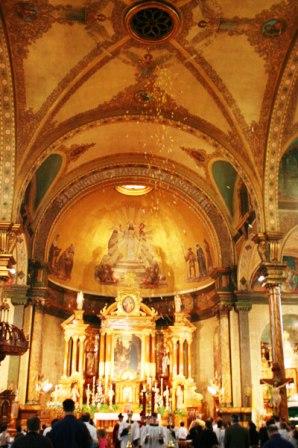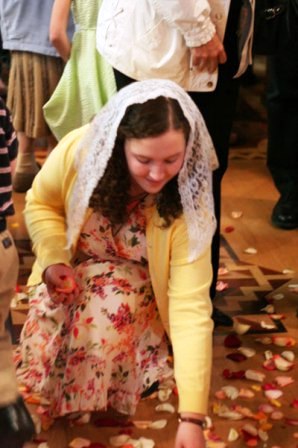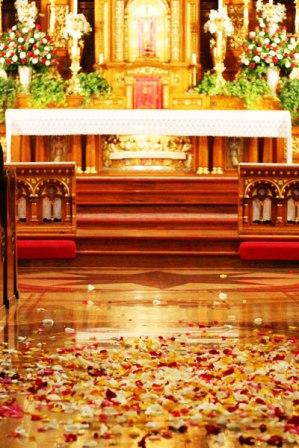I had posted about the dropping of rose petals through the oculus of the Pantheon on Pentecost Sunday.
A few people alerted me to other places where this custom is observed.
This is from a reader, with photos of St. John Cantius in Chicago:





I had posted about the dropping of rose petals through the oculus of the Pantheon on Pentecost Sunday.
A few people alerted me to other places where this custom is observed.
This is from a reader, with photos of St. John Cantius in Chicago:




Comments are closed.


Coat of Arms by D Burkart
St. John Eudes
- Prosper of Aquitaine (+c.455), De gratia Dei et libero arbitrio contra Collatorem 22.61
Nota bene: I do not answer these numbers or this Skype address. You won't get me "live". I check for messages regularly.
![]()
![]()
WDTPRS


020 8133 4535


651-447-6265
“He [Satan] will set up a counter-Church which will be the ape of the Church because, he the devil, is the ape of God. It will have all the notes and characteristics of the Church, but in reverse and emptied of its divine content. It will be a mystical body of the anti-Christ that will in all externals resemble the mystical body of Christ. In desperate need for God, whom he nevertheless refuses to adore, modern man in his loneliness and frustration will hunger more and more for membership in a community that will give him enlargement of purpose, but at the cost of losing himself in some vague collectivity.”
“Who is going to save our Church? Not our bishops, not our priests and religious. It is up to you, the people. You have the minds, the eyes, and the ears to save the Church. Your mission is to see that your priests act like priests, your bishops act like bishops.”
- Fulton Sheen
Therefore, ACTIVATE YOUR CONFIRMATION and get to work!
- C.S. Lewis
PLEASE subscribe via PayPal if it is useful. Zelle and Wise are better, but PayPal is convenient.
A monthly subscription donation means I have steady income I can plan on. I put you my list of benefactors for whom I pray and for whom I often say Holy Mass.
In view of the rapidly changing challenges I now face, I would like to add more $10/month subscribers. Will you please help?
For a one time donation...



"But if, in any layman who is indeed imbued with literature, ignorance of the Latin language, which we can truly call the 'catholic' language, indicates a certain sluggishness in his love toward the Church, how much more fitting it is that each and every cleric should be adequately practiced and skilled in that language!" - Pius XI
"Let us realize that this remark of Cicero (Brutus 37, 140) can be in a certain way referred to [young lay people]: 'It is not so much a matter of distinction to know Latin as it is disgraceful not to know it.'" - St. John Paul II
Grant unto thy Church, we beseech Thee, O merciful God, that She, being gathered together by the Holy Ghost, may be in no wise troubled by attack from her foes. O God, who by sin art offended and by penance pacified, mercifully regard the prayers of Thy people making supplication unto Thee,and turn away the scourges of Thine anger which we deserve for our sins. Almighty and Everlasting God, in whose Hand are the power and the government of every realm: look down upon and help the Christian people that the heathen nations who trust in the fierceness of their own might may be crushed by the power of thine Arm. Through our Lord Jesus Christ, Thy Son, who liveth and reigneth with Thee in the unity of the Holy Ghost, God, world without end. R. Amen.
If you travel internationally, this is a super useful gizmo for your mobile internet data. I use one. If you get one through my link, I get data rewards.






Visits tracked by Statcounter
since Sat., 25 Nov. 2006:
Father, if this blog post is reliable, it’s also a custom at 5th Avenue Prebyterian in New York.
Oh my, but that is lovely.
The pictures are great, Father. Thank you.
Dadburnit! And I attended the earlier low Mass and missed this event!
I am curious–if this custom is to be observed (and indeed it is beautiful) at what point in the liturgy ought the petals be dropped?
I checked the ;post referredto by Puella and the Presbyterian churh inqueston did indeed drop rose petals. Maybe they recognized a good custom.
These pictures remind me that it is too cute being holy. :D
Phil,
During the Sequence “Veni, Sancte Spiritus”.
We went on a pilgrimage last week with our parish to St. John Cantius. It is truly a beautiful church and parish. We are planning to go for TLM so our children can experience it since our parish has been told by our bishop that they are not allowed to offer TLM until further notice.
While this is a pretty thing, can you SERIOUSLY tell me this is appropriate? Everyone in the traditional movement cries foul about “innovations” and then they drop rose pedals from the ceiling. How can you complain when you’re doing the same thing? If someone were to drop balloons from the ceiling, someone would shout “HERETIC”. You all have to choose one or the other. I for one am getting tired of being dragged back and forth between the two.
– The Neo-Con
Done also on The Feast of Corpus Christi, at Flensburg, Mn. at 10:00 Mass. It is really quite beautiful. There are also 22 alter boys of all ages, to assist Fr Hoppe.
James,
Does it help that judging from the first picture this is clearly (pace Prof. Basto) done after mass?
James: can you SERIOUSLY tell me this is appropriate
Um… yes. This is appropriate.
It is also, at least at the Pantheon in Rome, done at the conclusion of Mass after the blessing.
I am surprised this is done inside a church. Most churches do not permit flower petals or rice etc for weddings, inside or outside the church.
James, the rose petals symbolize the tongues of flame that appeared on the first Pentecost. Balloons symbolize Bozo the Clown. No comparison.
So, Anita, you can point to a rubric or liturgical directive that states that there is a liturgical norm for dropping flowers from the ceiling? I’m not trying to be difficult, really, [uh huh] but this is a two way street people, and many are only seeing one way.
Not to make too silly of a liturgical example, Fr. Z., but simply citing that it happens in the Pantheon does not make it “appropriate”. For example, if one were to release butterflies at the conclusion of the Easter liturgy in St. Peters, it wouldn’t make it any more appropriate than releasing them in the “Cathedral of Light” in Oakland. The liturgy is universal, not particular to a building.
Rose petals symbolize the flames? Balloons symbolize prayers rising to God….butterflies the Resurrection of Christ….liturgical dancers the freenes of God’s loving presence….when do we stop symbolizing non-sacramental things and start resting in the sacraments and sacramentals themselves. Flames are flame is fire….not a flower. [As much as I think naplam would be useful in some of the ugly churches I have seen, I think most of the congregation would resent it.]
Sometimes, I just want to run back to the proggies because sometimes (we) the traddies just seem a bit hypocritical. [Puhleeze… this is something that takes place after Mass.]
I’m sure you’re going to attack me…go ahead….if it makes you feel better. [Well boo hoo! Aren’t we just going to pick on you now! o{]:¬) ]
James: BTW… you might have missed the part that it happens after Mass.
AFTER Mass.
James: While this is a pretty thing, can you SERIOUSLY tell me this is appropriate? Everyone in the traditional movement cries foul about “innovations” and then they drop rose pedals from the ceiling. How can you complain when you’re doing the same thing?
So many missteps here … Where to start in correcting them?
Well, for one thing, you seem to think this post has something specifically to do with “the traditional movement”. Actually, roses were dropped at the 11 am solemn Novus Ordo Mass at St. John Cantius Church on Pentecost Sunday, when I’d assume the photos above were taken.
Then you seem to think that dropping roses on Pentecost is an innovation. Actually, in various locations it is a venerable custom dating back at least to the 13th century (and apparently much earlier in Rome):
“Formerly, in certain churches, while the Veni Sancte Spiritus was being sung, a shower of red roses was let fall from the roof, while a dove flew about over the heads of the faithful. Hence the pleasing name of the Easter of Roses by which Pentecost was known in the thirteenth century. Sometimes, to add another feature to the attempt to give a scenic character to the ceremonial, a trumpet was sounded during the Sequence as a reminder of the trumpet of Sinai or the mighty sound in the midst of which the Holy Spirit descended upon the apostles.” (The St. Andrew Daily Missal)
And then you seem to think that traditional Catholics are opposed to all changes in the liturgy. Not so, only to those that are wrong-headed and counter to orthodox faith and liturgy. The difference from the “proggies” (if I understand your innovative term correctly) is that faithful Catholics know what is and what is not consistent with orthodox faith and liturgy.
And you seem to think that appropriateness in liturgy is simply blind adherence to written rubric. Or do you?
Roses were dropped after the 9 am and 11 am Masses (Ordinary Form) and after the 12:30 pm Mass (Extraordinary Form)at St John Cantius, Chicago, Pentecost.
If I am not much mistaken, on the Feast of Our Lady of the Snows, white rose petals are dropped from the ceiling at St Mary Major Basilica.
In addition to all of the special blessings in the Roman Ritual, such as the blessing of wine on the Feast of St. John the Divine, the blessing of gold, chalk and incense on Epiphany, etc., carried out at St John Cantius Church, the Canons Regular of St. John Cantius also foster those devotions and customs that enjoy a long history in the Church, such as the dropping of rose petals on Pentecost and the burial of the Alleluia before Easter.
In many places, there arose the custom of literally “burying the alleluia,” just as, in some places, “Carnival” is buried on Ash Wednesday, and “Lent” is buried on Holy Saturday. Francis Weiser’s “Easter Book” (1954) cites a fifteenth-century statute book of the Church of Toul, which reads:
“On Saturday before Septuagesima Sunday all choir boys gather in the sacristy during the prayer of the None, to prepare for the burial of the Alleluia. After the last Benedicamus [i.e., at the end of the service] they march in procession, with crosses, tapers, holy water and censers; and they carry a coffin, as in a funeral. Thus they proceed through the aisle, moaning and mourning, until they reach the cloister. There they bury the coffin; they sprinkle it with holy water and incense it; whereupon they return to the sacristy by the same way.”
This book also tells us that in “Paris, a straw figure bearing in golden letters the inscription ‘Alleluia’ was carried out of the choir at the end of the service and burned in the church yard.”
How rich and expressive is our Catholic faith!
So, Fr. Z., it must be inferred that you condone the use of liturgical dance as long as it’s before or after mass, correct? Clowns? If you want to use that argument (and the picture doesn’t support it, by the way – they are STILL in procession), than anything goes in church as long as it’s not between the signs of the cross. Hmmmmm….slippery slope…. [You are, perhaps, trying to provoke me.]
No Father, I wouldn’t try and provoke you. I respect you too much to do that. I’m trying to get people to see that things aren’t so narrow as they seem to think. I’m going to share with you a bit of my story…I learned about liturgy from someone who thought that their way was the only way. She was progressive, narrow-minded, and quite brilliant (2 STD’s and a couple other degrees). I spent most of my life thinking that the only way to do liturgy was how she taught me. Only until recently (2 years ago) did I discover the rich tradition and history of the Catholic liturgy. Thanks be to God. I am an intelligent man working on a degree in Liturgical Theology. I am currently in dialogue with many people on both sides of the “liturgical fence”. I am labeled a “neo-con” and I accept that with pride! However, I fear there are errors on both sides to be looked at.
The traditionalists take the side that innovation in liturgy has become rampant and must be halted. Amen! The progressives take the side that Vatican II was the work of the Spirit and that work included a revision of the Roman Rite. Amen! Both sides have unfortunately gone off the deep end. The progressives have on occasion (we’ll leave it at that) made a mockery of the liturgy and harmed the spiritual and liturgical life of our Church. The traditionalists have been given the gift of Summorum Pontificum, and unfortunately they are using it as a battle cry and weapon in a liturgical war. People on both sides seem to have lost their focus. We are involved in a spiritual battle with Satan for the salvation of souls. We cannot afford to be battling each other. Yet what I read all too often on blogs like WDTPRS, AmP and others is bashing, hatred and ignorance. I’m tired of being stuck in the middle searching for the truth while people on both sides act like children. There is only ONE truth — and it is found in Christ Jesus our Lord.
There you have it. I do appreciate many of the things here on your site – especially the “slavishly accurate liturgical translations”. I just wish things were a bit more balanced.
J